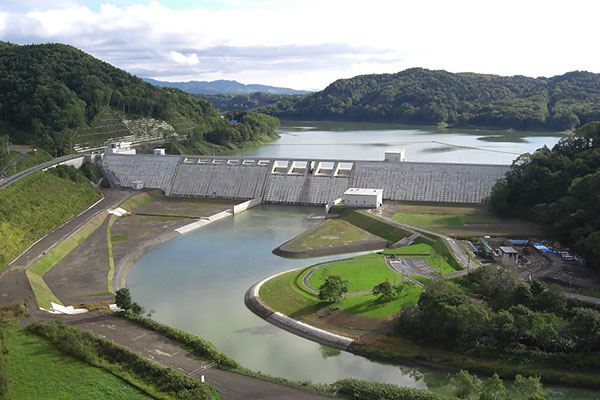
Photograph source:「Concrete Structure in Hokkaido」(Hokkaido Branch ,Japan Concrete Institute)
| Structure name | Toubetsu DAM |
|---|---|
| Structure type | Trapezoidal CSG Dam |
| Purpose | Flood control、Non-specified, river flow maintenance、Water supply for city water、Water sypply for Agriculture |
| Structural factors | Height 52.0m、Crest length、Volume 803×10 3m3、Ponding area 580ha、Total reservoir capacity 74,500×10 3m3 |
| Operator | Hokkaido Government |
| Designer | Japan Dam Engineering Center、Docon Co.,Ltd |
| Contractor | Kajima Co. 、Takenaka Civil Engineering & Construction Co., Ltd.、Iwakura Construction Co., Ltd |
| Location | Tohbetsu town |
| River system | Ishikari river / Tohbestu river |
| Completion date | 2012 |
| Overview | The Toubetsu Dam is the first trapezoidal CSG (Cemented Sand and Gravel) in the world, with a bank height of 52.5 meters, bank length of 432 meters, and 803,000 cubic meters of volume in the bank. The trapezoidal CSG dam combines the advantages of both the trapezoidal dam and the CSG construction method, and was developed by Japan as a dam model that can simultaneously achieve rationalization of materials, design, and construction. The volume of the trapezoidal dam is larger than that of a right angle, triangular shaped gravity dam. However, since the stress generated in the bank is small, it is possible to use materials with low strength. This also provides a high safety ratio against falling and sliding. The CSG method uses a mixture of cement and water added to riverbed gravel, which can be collected around the site, along with rocky material generated during the civil engineering works. It is possible to effectively utilize riverbed gravel and excavation slurry, which can be easily obtained near the dam site, to simplify the equipment necessary for manufacturing the aggregates. It also enables use of more general-purpose machines such as dump trucks and bulldozers. This method thus allows for speedy, mass production and inexpensive construction. |

